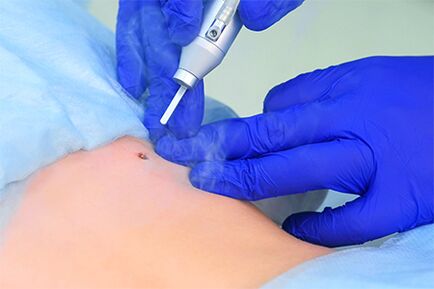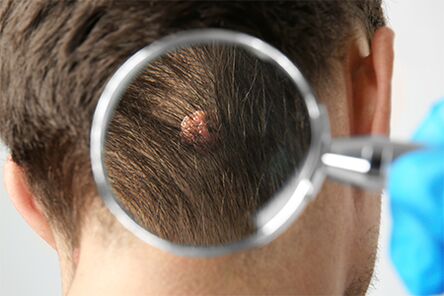A significant proportion of tumors on the human skin are caused by the activity of the human papillomavirus (HPV). Meanwhile, papillomas are the most common of them all. The virus not only caused the tumor to appear, but gave it its name. But not all patients today know what papilloma is. If you are one of these people, or just want to learn more about this tumor, this article is for you. In it we discuss papilloma: what it is, what symptoms it has, why it forms and how to treat it

Papilloma: what is it
Papillomas are small tumors that are the same or a slightly different color than healthy skin. Tumors can appear singly or in multiple rashes. Depending on the species, they can be flat, pedunculated, and elongated in the form of papillae. These tumors are found almost everywhere: on the genitals, face, neck, armpits, extremities, etc.
It is also worth noting that papillomas are benign tumors. That is, they are not tumors. However, doctors do not recommend leaving them as they are.
Usually papillomas do not hurt, but in some cases they can itch, flake off, cause mild stinging, and/or redness. If the papilloma is in the intimate area, it can cause discomfort when moving.
Types of Papillomas
The five most common types of papillomas are:
- simple. It looks like celosia or cauliflower.
- flat. These tumors are flat nodules on the surface of the skin. It can also form in the cervix.
- Filiform. They are most often located on thin skin and are elongated nodules. Usually seen in people over the age of 50.
- tip. or warts. It is transmitted sexually and therefore most often forms in the genital area. They may appear one at a time, or several at the same time. In this case, they can merge into one large papilloma. They also differ in that they not only form on the surface of the reproductive organs, but can also grow inside the urethra or cervix.

Why Papillomas Occur
As we wrote above, the main reason for the appearance of papillomas is the activity of HPV. Remarkably, according to the World Health Organization, approximately four in five (or more) people are infected with papillomavirus today. This is due to several reasons:
- The virus is very durable. Once infected, it is nearly impossible to get rid of it.
- Viruses spread easily. Sometimes even one use of a toilet seat or towel is enough to get an infection. And unprotected sex has almost 100% chance of infection.
- The virus is congenital. Usually, the virus is passed from mother to newborn, so many people are born with papillomavirus infection.
In general, although our immunity will not eliminate the virus, it can suppress it very well. That's why tumors don't appear in all infected people. But papillomas (or another type of tumor caused by HPV) may develop if the immune system is weakened. There are other factors that may favor the development of papillomas:
- Stress and emotional stress.
- advanced age.
- Alcoholism, smoking.
- Excessive physical activity.
- Vitamin deficiency in the body.
- some other diseases. Such as endocrine diseases.
- Taking certain medicines (oral contraceptives, immunosuppressants).
- Promiscuous sex.
After the virus enters the human body, the external manifestations of papilloma will not appear immediately. what does it depend on? from the immune status and the duration of the incubation period (from weeks to years). Therefore, if the immune protection status is good, the first symptoms may appear even after a year. In this case, a person can be infected with more than one type of HPV (there are about 170 types) at the same time.
Papilloma Treatment
Of course, not everyone knows what papillomas are and how to treat them. Some people don't even think it's necessary to treat them because these tumors are benign. Doctors disagree on the matter: papillomas should be treated, and it is better not to postpone treatment. So why treat this benign tumor? First, papillomas can transform into malignant tumors. Especially under the influence of certain factors. For example, due to intense UV exposure, injury, inflammation. Second, tumors negatively impact female reproductive function. If the woman becomes pregnant without being cured, the virus is most likely to be transmitted to the newborn. Third, papillomas located in the throat or trachea can cause breathing difficulties and even suffocation. Fourth, as mentioned earlier, papillomaviruses spread easily, so untreated tumors can be highly contagious. Fifth, tumors can cause aesthetic discomfort.
Types of Papilloma Treatment
It should be noted immediately that you cannot resort to self-medication. Only a medically educated specialist knows how to diagnose papilloma, what it is and how to treat it. At the same time, it must be remembered that when resecting any tumor, it is advisable to send the resected tissue for histological examination.
When it comes to treatment, today you have several options to get rid of tumors.
- Surgery. The surgery is performed under local anesthesia. The tumor is removed with a scalpel along with adjacent healthy tissue. Therefore, the healing process can take a long time. In addition, there is a high risk of scarring at the excision site. For these reasons, this procedure is rarely performed at present. Mainly when other methods have failed or the tumor is too large.
- Low temperature damage. This is the name of a procedure that exposes tissue to ultra-low temperatures. Most of the time, the process is carried out using liquid nitrogen at a temperature of -196°C. As a result, the water in the cells at the exposed site freezes and the tumor dies. Disadvantages include low efficiency (approximately 60%), as the tumor is not sufficiently damaged due to insufficient freezing. And overdo it - healthy tissue can be damaged.
- Electrocoagulation. This is the name of the procedure for burning tumor tissue with an electric current. Among the disadvantages, they cite the soreness of the procedure and the potential for scarring of the skin at the exposed site. But the efficiency is quite high: about 95%.
- Tumors are removed by laser. The essence of the procedure is the effect of the laser beam on the tissue. As a result, the tumor evaporates layer by layer. Adjustable power enables you to remove papillomas with almost 100% efficiency. High precision allows you to rule out damage to healthy tissue. Today, laser ablation is considered by many experts to be one of the most effective ways to eliminate papillomas. There are almost no scars after the surgery, there is no need for a long recovery period, and the procedure is very comfortable for the patient because an anesthetic is applied before the procedure.
Clinically, laser resection of papillomas is performed using modern equipment. No preparation for laser removal is required. But you need to make an appointment with a laser therapist. At your appointment, your doctor will tell you what a papilloma is and how treatment will go. The patient will also be checked for contraindications.
The procedure itself is carried out very quickly: for a single tumor, a few minutes are enough, for multiple tumors - 15-20. After surgery, a specialist will tell you about proper care. According to the general instructions, sunbathing, bathhouses and saunas are not allowed for the first two weeks. You also need to take care of the treated area.
Do not forget about contraindications to surgery. Laser resection of papillomas is not performed in the presence of any disease, central nervous system lesions, and bleeding.


















